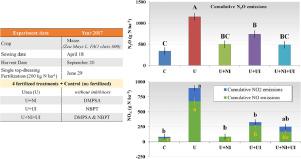当前位置:
X-MOL 学术
›
Agric. For. Meteorol.
›
论文详情
Our official English website, www.x-mol.net, welcomes your feedback! (Note: you will need to create a separate account there.)
Inhibitor-coated enhanced-efficiency N fertilizers for mitigating NOx and N2O emissions in a high-temperature irrigated agroecosystem
Agricultural and Forest Meteorology ( IF 6.2 ) Pub Date : 2020-10-01 , DOI: 10.1016/j.agrformet.2020.108110 Jaime Recio , Mónica Montoya , José Manuel Álvarez , Antonio Vallejo
Agricultural and Forest Meteorology ( IF 6.2 ) Pub Date : 2020-10-01 , DOI: 10.1016/j.agrformet.2020.108110 Jaime Recio , Mónica Montoya , José Manuel Álvarez , Antonio Vallejo

|
Abstract Nitrogen (N) fertilizers have substantially increased global crop yields around the world during recent decades. Nevertheless, the extensive use of N fertilizers at global scale has converted agricultural fertilized soils into an important anthropogenic source of nitrous oxide (N2O) and nitric oxides (NO+NO2 = NOx). The application of enhanced-efficiency N fertilizers, with the addition of urease and nitrification inhibitors (UI and NI, respectively), facilitates the reduction of N2O and NOx emissions and the improvement of agronomic responses. Despite the fact that soil N2O emissions have been widely studied under a large variety of climatic conditions and with different enhanced-efficiency N fertilizer, few studies have focused on soil NOx emissions, particularly in high temperature environments. The main aim of this study, therefore, was the quantification of NO and NO2 fluxes at a high temporal resolution using an automatic measurement system with the capacity to evaluate 5 different treatments with three replicates, and the ambient gas concentration. In addition, N2O emissions were measured with the static chamber method. With respect to the urea (U) treatment, the results confirm a significant mitigation of N2O and NO losses with the use of the new experimental inhibitor, DMPSA, alone or combined with the urease inhibitor NBPT. Overall, NOx emissions decreased by more than 60% in all the treatments in which synthetic inhibitors (both UI and NI) were applied, while N2O emissions were reduced by more than 35% in all the fertilized treatments when compared with urea alone. The high temporal resolution allowed the observation of negative fluxes of NO and NO2 in the different treatments, although these were more frequent and intense in the U+NI treatment. In general, grain and biomass yield were not affected by the use of NI or UI. The combined result was that a substantial reduction of yield-scaled-N2O and yield-scaled-NOx emissions was obtained when these inhibitors were used with urea and, therefore, their use should be recommended for mitigating these emissions whilst maintaining yields.
中文翻译:

用于减少高温灌溉农业生态系统中 NOx 和 N2O 排放的抑制剂涂层增效氮肥
摘要 近几十年来,氮 (N) 肥料大大提高了全球作物产量。尽管如此,全球范围内广泛使用氮肥已将农业施肥土壤转化为一氧化二氮 (N2O) 和一氧化氮 (NO+NO2 = NOx) 的重要人为来源。施用增效氮肥,并添加尿素酶和硝化抑制剂(分别为 UI 和 NI),有助于减少 N2O 和 NOx 排放并改善农艺反应。尽管在各种气候条件下和使用不同的增效氮肥对土壤 N2O 排放进行了广泛研究,但很少有研究关注土壤 NOx 排放,特别是在高温环境中。因此,本研究的主要目的是 是使用自动测量系统以高时间分辨率对 NO 和 NO2 通量进行量化,该系统能够通过三个重复评估 5 种不同的处理,以及环境气体浓度。此外,N2O 排放量是用静态室法测量的。关于尿素 (U) 处理,结果证实,单独使用新的实验抑制剂 DMPSA 或与尿素酶抑制剂 NBPT 联合使用,N2O 和 NO 损失显着减少。总体而言,与单独使用尿素相比,在所有施用合成抑制剂(UI 和 NI)的处理中,NOx 排放量减少了 60% 以上,而在所有施肥处理中,N2O 排放量减少了 35% 以上。高时间分辨率允许在不同处理中观察到 NO 和 NO2 的负通量,尽管这些在 U+NI 处理中更为频繁和强烈。一般来说,谷物和生物量产量不受使用 NI 或 UI 的影响。综合结果是,当这些抑制剂与尿素一起使用时,产量规模的 N2O 和产量规模的 NOx 排放量显着减少,因此,应推荐使用它们来减少这些排放,同时保持产量。
更新日期:2020-10-01
中文翻译:

用于减少高温灌溉农业生态系统中 NOx 和 N2O 排放的抑制剂涂层增效氮肥
摘要 近几十年来,氮 (N) 肥料大大提高了全球作物产量。尽管如此,全球范围内广泛使用氮肥已将农业施肥土壤转化为一氧化二氮 (N2O) 和一氧化氮 (NO+NO2 = NOx) 的重要人为来源。施用增效氮肥,并添加尿素酶和硝化抑制剂(分别为 UI 和 NI),有助于减少 N2O 和 NOx 排放并改善农艺反应。尽管在各种气候条件下和使用不同的增效氮肥对土壤 N2O 排放进行了广泛研究,但很少有研究关注土壤 NOx 排放,特别是在高温环境中。因此,本研究的主要目的是 是使用自动测量系统以高时间分辨率对 NO 和 NO2 通量进行量化,该系统能够通过三个重复评估 5 种不同的处理,以及环境气体浓度。此外,N2O 排放量是用静态室法测量的。关于尿素 (U) 处理,结果证实,单独使用新的实验抑制剂 DMPSA 或与尿素酶抑制剂 NBPT 联合使用,N2O 和 NO 损失显着减少。总体而言,与单独使用尿素相比,在所有施用合成抑制剂(UI 和 NI)的处理中,NOx 排放量减少了 60% 以上,而在所有施肥处理中,N2O 排放量减少了 35% 以上。高时间分辨率允许在不同处理中观察到 NO 和 NO2 的负通量,尽管这些在 U+NI 处理中更为频繁和强烈。一般来说,谷物和生物量产量不受使用 NI 或 UI 的影响。综合结果是,当这些抑制剂与尿素一起使用时,产量规模的 N2O 和产量规模的 NOx 排放量显着减少,因此,应推荐使用它们来减少这些排放,同时保持产量。



























 京公网安备 11010802027423号
京公网安备 11010802027423号